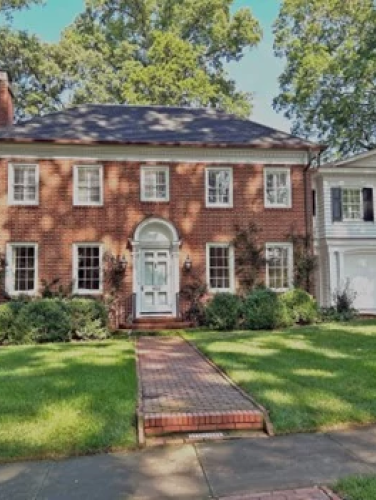
Marion R. and Lavonne Marsh House
(ca. 1929)
One of Charlotte’s most notable architects designed and lived for nearly fifty years in the Marion R. and Lavonne Marsh House.
1642 Hertford Rd, Charlotte, NC 28207
The Marion R. and Lavonne Marsh House, located in the Myers Park National Register Historic District, was the home of one of the most influential and successful architects in Charlotte and the greater North Carolina piedmont. Marion Rossiter “Steve” Marsh (1893-1977) designed his family’s Colonial Revival home and lived here for nearly fifty years, including during the most prolific time in his career. Although a licensed architect and engineer, Marsh never earned a college degree. He instead learned his trade as a draftsman apprentice at his brother’s architectural firm in Jacksonville, Florida, and through correspondence course from Columbia University. Marsh and his brother designed several camps for the U.S. Army during World War I.
Property Quick Links
Marsh moved to Charlotte in 1916 to become chief draftsman for the architectural firm of James M. McMichael and later, the chief architect of the chemical engineering firm of Peter Gilchrist. McMichael, one of the principal church architects in North Carolina in the early 20th century, designed over 900 churches by the end of his career. Marsh’s formative years under McMichael were significant to his professional development, immersing him in the architecture of religious, public, and residential buildings across the state. In 1917, Marsh married Catherine “Lavonne” Maxwell (1897-1948) and together, they raised two daughters in their Myers Park home. Following Lavonne’s death, Marsh deeded the house to eldest daughter Elizabeth and her husband Palmer Quackenbush, who had been living in the home with Marsh since their marriage in 1963.
Marsh started his own firm “M. R. Marsh Architect & Engineer” in 1922, designing numerous theaters, Masonic lodges, and residences in various Classical styles from 1922 to 1964, during Charlotte’s major development boom. Several of his buildings are designated on the national and local level for their architectural significance. Locally, his Builders Building on West Trade Street, the Carolina Cadillac Company building on South Tryon Street, the Coca-Cola Bottling Plant on West Morehead Street, Fire Station #2 on South Boulevard, and Eastover Elementary School are all local designated landmarks. The Marsh-designed Fritz Seifart House and Gem Theater in Kannapolis, North Carolina, are included on the National Register of Historic Places.
The Builders Building is particularly notable. It was constructed as a showcase for the technological advancement of modern 1929 Charlotte and the abilities of the city’s construction professionals. Of all the significant architects in Charlotte at that time – including Lous Asbury, James McMichael, Martin Boyer, C. C. Hook, and William Peeps – it was Marsh that won the plum assignment of designing the premier office building for the city’s architects, realtors, surveyors, general contractors, and other construction professionals. Marsh also designed the World War II Morris Field Army Air Base that later became the site for Charlotte Douglas Airport, several chemical plants in Central and South America, and was the first Charlotte architect to design a local apartment building with an electric elevator.

